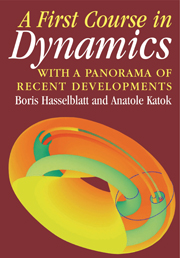Book contents
- Frontmatter
- Contents
- Preface
- 1 Introduction
- PART 1 A COURSE IN DYNAMICS: FROM SIMPLE TO COMPLICATED BEHAVIOR
- PART 2 PANORAMA OF DYNAMICAL SYSTEMS
- 9 Simple Dynamics as a Tool
- 10 Hyperbolic Dynamics
- 11 Quadratic Maps
- 12 Homoclinic Tangles
- 13 Strange Attractors
- 14 Variational Methods, Twist Maps, and Closed Geodesics
- 15 Dynamics, Number Theory, and Diophantine Approximation
- Reading
- APPENDIX
- Hints and Answers
- Solutions
- Index
15 - Dynamics, Number Theory, and Diophantine Approximation
Published online by Cambridge University Press: 05 June 2012
- Frontmatter
- Contents
- Preface
- 1 Introduction
- PART 1 A COURSE IN DYNAMICS: FROM SIMPLE TO COMPLICATED BEHAVIOR
- PART 2 PANORAMA OF DYNAMICAL SYSTEMS
- 9 Simple Dynamics as a Tool
- 10 Hyperbolic Dynamics
- 11 Quadratic Maps
- 12 Homoclinic Tangles
- 13 Strange Attractors
- 14 Variational Methods, Twist Maps, and Closed Geodesics
- 15 Dynamics, Number Theory, and Diophantine Approximation
- Reading
- APPENDIX
- Hints and Answers
- Solutions
- Index
Summary
Some questions in the theory of numbers that go back to the work of Dirichlet, Jacobi, Kronecker, and Weyl can be viewed retrospectively as one of the principal sources of modern dynamics. A fruitful interaction has developed in both directions: Dynamical methods often provide new and sometimes unexpected insights into problems in analytic number theory, and, on the other hand, algebraic number theory provides tools for studying some model dynamical systems to greater depth than more general analytic, topological, and geometric methods allow.
The contents of the first four sections of this chapter are classical and are meant to demonstrate the usefulness of the dynamical approach to the problems of uniform distribution and Diophantine approximation of numbers. Along the way the prominent role of hyperbolic geometry becomes apparent. The last section gives a brief account of one of the top achievements of the dynamical approach to analytic number theory: the proof of Oppenheim's conjucture about small values of quadratic forms in three variables.
UNIFORM DISTRIBUTION OF THE FRACTIONAL PARTS OF POLYNOMIALS
In this section we describe how some general dynamical arguments establish the uniform distribution results (unique ergodicity; see Section 4.1.4) for special dynamical systems needed to solve a number-theoretic problem discussed in the Introduction (Section 1.3.5) and its generalizations. Unique ergodicity (Definition 4.1.18) is essential for establishing uniform distribution for specific sequences because a given sequence is associated with a particular orbit of the dynamical system.
Information
- Type
- Chapter
- Information
- A First Course in Dynamicswith a Panorama of Recent Developments, pp. 365 - 385Publisher: Cambridge University PressPrint publication year: 2003
